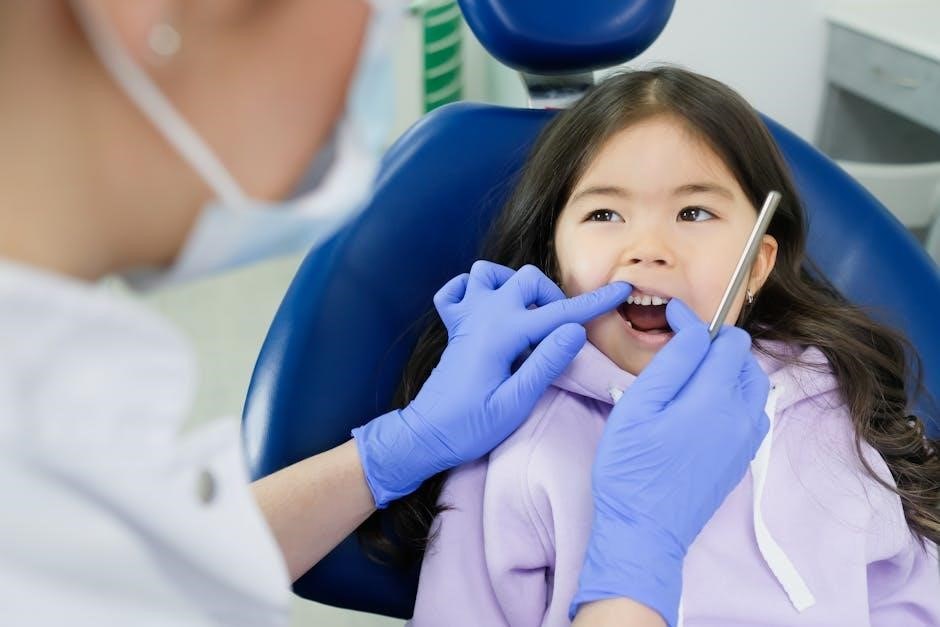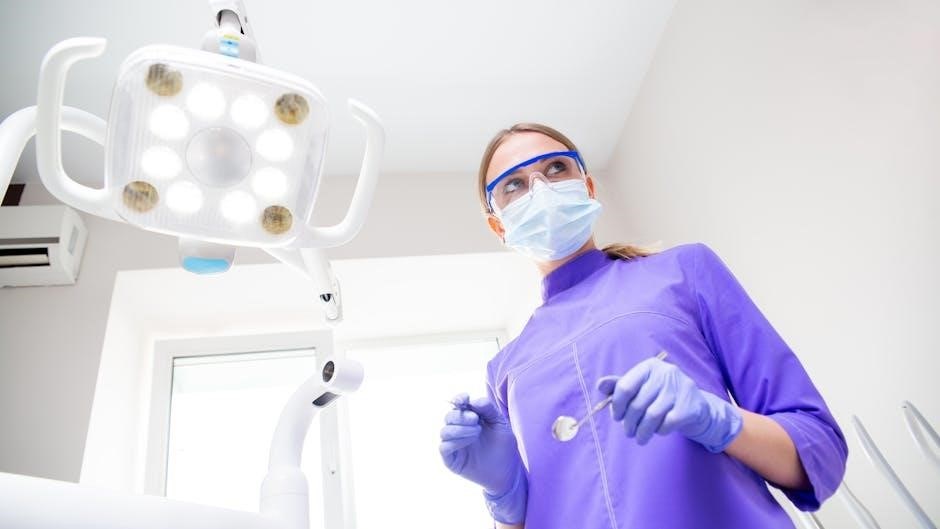The oral mechanism examination is a key assessment tool in speech therapy, evaluating the structure and function of oral structures to identify impairments affecting speech production.
Overview of the Oral Mech Exam
An oral mechanism examination is a one-page assessment tool designed for speech-language pathologists (SLPs) to evaluate oral structures and functions. It includes a checklist for observing lips, tongue, teeth, and palate, both at rest and during specific movements. The exam assesses strength, range of motion, and symmetry, helping identify structural or functional impairments. Detailed instructions and diagrams guide SLPs through the process, ensuring accuracy and efficiency in identifying key aspects of oral motor function and speech production.
Importance of the Oral Mech Exam in Speech Therapy
The oral mechanism exam is a fundamental assessment tool for speech-language pathologists (SLPs), providing insights into the structural and functional integrity of oral structures. It helps identify impairments in lips, tongue, and palate movement, which are critical for speech production. By pinpointing these issues, SLPs can develop targeted therapies to address speech sound disorders. The exam also aids in differential diagnosis, distinguishing between structural and functional causes of speech difficulties, ensuring effective and personalized treatment plans.

Purpose and Scope of the Oral Mechanism Exam
The oral mechanism exam assesses the structure and function of oral structures to identify impairments affecting speech production, guiding personalized therapy plans.
Evaluating Structural and Functional Integrity
Evaluating structural and functional integrity involves assessing the physical condition and movement capabilities of oral and facial structures. This includes observing the lips, tongue, jaw, and palate at rest and during specific tasks. The examiner checks for symmetry, range of motion, and strength, using tools like tongue depressors to test resistance and coordination. Any abnormalities or limitations in movement are documented to identify potential impairments affecting speech and feeding abilities, ensuring targeted interventions.
Identifying Key Aspects of Oral Motor Function
Identifying key aspects of oral motor function involves assessing the tongue, lips, and jaw movements to determine their strength, coordination, and symmetry. The exam evaluates the ability to perform specific tasks, such as protruding the tongue, blowing, or forming speech sounds. Tools like tongue depressors are used to test resistance and endurance. Observing these functions helps pinpoint motor impairments, such as apraxia or dysarthria, which are critical for developing targeted speech therapy strategies and improving communication skills effectively.
Structure of the Oral Mechanism Exam
The oral mechanism exam follows a sequential process, starting with visual observation of facial and oral structures, then assessing internal functions like tongue, lip, and jaw movements using checklists and diagrams for accuracy.
Visual Observation of Oral and Facial Structures
Visual observation is the first step in an oral mechanism exam, assessing facial symmetry and inspecting oral structures like lips, tongue, teeth, and jaw. This step involves checking for visible abnormalities or structural issues that might impact speech. Documentation is done using detailed checklists to identify potential impairments early, ensuring a comprehensive assessment and effective therapy planning.
Assessment of Tongue, Lips, and Jaw Movements
The assessment evaluates the range of motion, strength, and coordination of the tongue, lips, and jaw. Specific movements, such as tongue protrusion, lateral movement, and jaw opening, are observed. Strength is tested using resistance, like pushing against a tongue depressor. Symmetry and stimulability are noted to identify potential motor impairments. This step helps determine if oral motor deficits contribute to speech or feeding challenges, guiding targeted interventions.
Key Components of the Exam
Key components include assessing symmetry, range of motion, strength, and coordination. Tools like checklists and diagrams ensure accuracy, while instruments aid in evaluating specific functions.
Checking for Symmetry and Range of Motion
Checking for symmetry and range of motion involves visually inspecting the face, lips, tongue, and jaw for alignment and movement. The examiner observes the client’s ability to move these structures evenly and fully. Abnormalities such as asymmetry or limited motion may indicate structural or functional impairments. This assessment helps identify potential barriers to speech production and guides further evaluation or therapy. Tools like tongue depressors may be used to test strength and endurance during specific tasks.
Evaluating Strength and Coordination
Evaluating strength and coordination involves assessing the client’s ability to perform specific oral motor tasks. Strength is tested by having the client push against a tongue depressor or resist movement. Coordination is observed through repetitive movements, such as alternating tongue positions. These evaluations help identify impairments affecting speech production. Findings guide targeted therapy strategies, addressing issues like apraxia or dysarthria. This step ensures a comprehensive understanding of the client’s oral motor capabilities and their impact on communication skills.
Referrals and Collaborations
Referrals to specialists like orthodontists or ENTs are essential when structural issues exceed SLP expertise. Collaborative efforts ensure comprehensive care for clients with complex oral motor or anatomical challenges.
When to Refer to Other Professionals
Referral to specialists such as orthodontists, ENTs, or occupational therapists is necessary when structural or functional impairments are beyond the SLP’s scope. Significant anomalies like severe misalignment of teeth, hearing loss, or neurological deficits warrant interdisciplinary collaboration. Early referrals ensure comprehensive care for clients with complex needs. SLPs should also seek input from medical professionals when oral motor issues persist or require surgical intervention. Timely referrals enhance therapy outcomes and address underlying conditions effectively.
Interdisciplinary Approach in Diagnosis
An interdisciplinary approach in diagnosis involves collaboration between SLPs, orthodontists, ENT specialists, and occupational therapists. This teamwork ensures a holistic understanding of oral motor and structural issues. By combining insights from various fields, professionals can identify complex impairments and develop comprehensive care plans. Such collaborations are especially crucial for clients with co-occurring conditions like hearing loss or neurological deficits, ensuring tailored interventions that address all aspects of their needs effectively.

Findings and Differential Diagnosis
The oral mechanism exam’s findings help identify structural or functional impairments, guiding the differential diagnosis of speech sound disorders. SLPs use these insights to pinpoint specific issues.
How Exam Results Inform Speech Sound Disorders
Oral mechanism exam results provide critical insights into speech sound disorders by identifying structural or functional impairments. Findings such as limited tongue range, weak lip strength, or poor coordination can directly correlate with specific articulation errors. For instance, impaired tongue mobility may lead to difficulties in producing precise consonant sounds. These results guide clinicians in tailoring interventions and ensuring targeted therapy approaches. Accurate documentation of these findings is essential for effective treatment planning and monitoring progress over time.
Documenting Structural and Functional Impairments
Accurate documentation of structural and functional impairments is crucial for tracking progress and planning therapy. Clinicians use detailed checklists and forms to record observations, such as lip closure, tongue mobility, and jaw alignment. Specific notations about asymmetries, limited range of motion, or weakness in oral structures are included. This documentation serves as a baseline for future comparisons and ensures targeted interventions. It also facilitates clear communication among professionals involved in the client’s care, supporting a cohesive treatment approach.

Visual Aids and Tools
Visual aids and tools, such as detailed checklists and diagrams, enhance the accuracy and consistency of oral mechanism exams. They provide a standardized way to assess and document findings, ensuring comprehensive evaluations.
Using Checklists and Diagrams for Accuracy
Checklists and diagrams are essential tools for ensuring accuracy during oral mechanism exams. They provide a structured format for assessing and documenting key aspects of oral motor function, such as lip, tongue, and jaw movements. Visual aids help speech-language pathologists (SLPs) systematically evaluate structural integrity and functional abilities, reducing the risk of oversight. Diagrams also serve as a visual reference, allowing for precise notation of findings, which is critical for developing targeted therapy plans and monitoring progress over time.
Role of Tongue Depressors and Other Instruments
Tongue depressors are invaluable tools in oral mechanism exams, enabling precise assessment of tongue strength, coordination, and range of motion. They are used to guide specific movements, such as protruding the tongue or moving it laterally. Other instruments, like mirrors and gloves, aid in evaluating oral structures and motor functions. These tools enhance the accuracy of observations, ensuring comprehensive documentation of oral motor abilities and structural integrity, which are critical for informed diagnosis and therapy planning.

Conducting the Exam Effectively
The oral mechanism exam can be efficiently completed in 2-3 minutes using a one-page checklist, ensuring accurate identification of structural and functional impairments for therapy planning.
Best Practices for SLPs
SLPs should begin with external observations of facial symmetry and oral structures. Utilize checklists and diagrams to ensure accuracy and consistency. Assess stimulability by prompting specific movements, such as protruding the tongue or smiling. Use tongue depressors to evaluate strength and range of motion. Maintain a calm and engaging demeanor to ensure client cooperation. Document findings thoroughly to inform therapy planning and monitor progress over time. Regular practice and updating assessment skills are essential for effective exam administration.
Ensuring Client Comfort and Cooperation
Creating a calm and professional environment is crucial for client comfort. Use clear, simple instructions and demonstrate tasks to ensure understanding. Engage clients with a friendly demeanor and adapt language to their age and comprehension level. Allow breaks if needed and provide positive reinforcement for cooperation. Position yourself at a comfortable height to minimize strain and ensure visibility. Make the process engaging, especially for children, to foster active participation and reduce anxiety during the oral mechanism examination.
The oral mechanism exam provides valuable insights into structural and functional impairments, guiding targeted therapy plans. Interpreting results helps develop personalized strategies, ensuring effective speech improvement and monitoring progress over time.
Interpreting Results for Therapy Planning
Results from the oral mechanism exam are crucial for developing targeted therapy plans. By identifying specific strengths and impairments, SLPs can tailor interventions to address motor deficits, such as limited tongue movement or poor lip closure. The findings guide the selection of appropriate exercises and activities, ensuring a personalized approach. This interpretation also helps set realistic goals for speech improvement and informs the progression of therapy. Regular monitoring of progress ensures adjustments are made to optimize outcomes.
Monitoring Progress Over Time
Regularly monitoring progress after an oral mechanism exam ensures therapy effectiveness. SLPs use checklists and baseline data to track improvements in oral motor skills. Reassessments help identify gains and areas needing adjustment. This ongoing process allows for tailored modifications to therapy plans, ensuring interventions remain targeted and effective. Progress monitoring also provides measurable outcomes, helping clients and caregivers understand advancements and stay motivated. Consistent follow-up supports long-term speech and motor development goals.